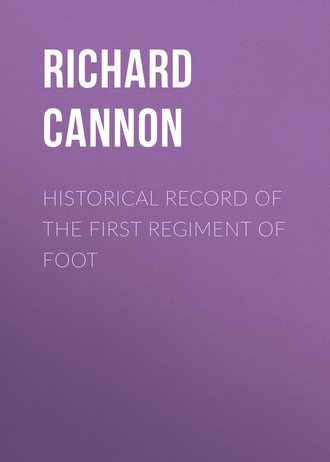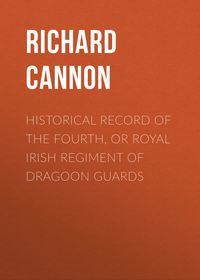 полная версия
полная версияHistorical Record of the First Regiment of Foot
The French republic had concluded a treaty of peace with Spain, and entered into negociations with the Portuguese; but the Queen of Portugal refused to ratify the treaty, and agreed to receive British troops into several ports of Portugal. The 2nd battalion of the Royal Regiment was, in consequence, withdrawn in the summer of 1797 from the island of Elba to proceed to Portugal; calling at Gibraltar, it there received drafts from the several regiments in that garrison, and, on its arrival in the river Tagus, it was placed in garrison at Cascaes, a small sea-port in the district of Torres Vedras, fifteen miles west of Lisbon, where the battalion was stationed during the remainder of this and the following year.
17981st Batt17992nd BattIn 1798 the 1st battalion, having recruited its numbers, proceeded from Great Britain to Ireland; and in the beginning of 1799 the 2nd battalion was withdrawn from Portugal, and after its arrival in England it was encamped on Barham Downs.
Bonaparte was at this period in Egypt, French troops were also engaged in operations on the Rhine, on the Danube, and elsewhere; and a favourable opportunity appeared to present itself for rescuing Holland from the power of France, into which it had fallen after the unfortunate issue of the campaign in the Netherlands in 1794. A plan of co-operation was concerted between Great Britain and Russia, in the expectation that the Dutch would rise in arms against the French, and in favour of the Prince of Orange, and, aided by the Anglo-Russian force, would exert themselves to effect their emancipation. The 2nd battalion of the Royal Regiment was selected to form part of the expedition to Holland, and it sailed from Deal on the 13th of August, with several other corps commanded by General Sir Ralph Abercombie, and, after some delay from contrary winds, landed on the 27th on the Dutch coast, near the Helder. A considerable body of French and Dutch troops assembled near the point of debarkation, some sharp fighting occurred, and in the evening the enemy retreated to a position six miles in his rear. The garrison in the Helder also abandoned its post, which was taken possession of on the following day by the 2nd battalion of the Royals and the 92nd Regiment. A numerous train of heavy and field artillery was found in this important post; and two days afterwards the Dutch fleet surrendered without striking a blow, and hoisted the colours of the Prince of Orange.
The Dutch people did not, however, manifest a disposition to rise against the French; but on the 10th of September the united French and Dutch forces attacked Sir Ralph Abercombie's position near Shagen, and were repulsed by the steady valour of the British troops. The British commander observed in his despatch, – "It is impossible for me to do full justice to the good conduct of the troops." The 2nd battalion of the Royal Regiment had Lieutenant Gordon and three private men wounded on this occasion.
Additional forces were sent from England, and His Royal Highness the Duke of York arrived and took the command of the army. A Russian force also arrived; and on the 19th of September an attack was made on the enemy's position, but, owing to the inconsiderate valour of the Russians, it failed. On the 2nd of October another attack was made on the enemy's positions between Bergen and Egmont-op-Zee, in which the Royals had another opportunity of signalizing themselves. "The points where this well-fought battle were principally contested were from the sea-shore in front of Egmont, extending along the sandy desert, or hills, to the heights above Bergen, and it was sustained by the British columns under those highly-distinguished officers General Sir Ralph Abercrombie and Lieut. – General Dundas, whose exertions, as well as the gallantry of the brave troops they led, cannot have been surpassed by any former instance of British valour102." The Royals were engaged with the enemy's troops occupying the sand-hills in front of Egmont-op-Zee, and lost on this occasion seven private men killed, Captains Barns and Hunter, Lieutenants Ainslie, Edmonston, Patten, Bowe, Fraser, and Johnstone, Ensign Birmingham, four serjeants, and sixty-one rank and file wounded, Lieutenant Hope wounded and taken prisoner, and ten rank and file missing.
The gallant conduct evinced by the battalion on this occasion was afterwards rewarded with the Royal permission to bear the word "Egmont-op-Zee" on its colours.
The Dutch people were not aroused by these gallant exertions on their behalf to make any attempt to deliver themselves from the power of France; and, several circumstances, calculated to render the expedition unsuccessful having occurred, it was decided that, instead of fighting for a people who were not resolved to be free, the troops should be withdrawn from Holland. A convention was in consequence concluded with the enemy, and the 2nd battalion of the Royal Regiment returned to England.
1st BattThe 1st battalion was stationed during the whole of this year in Ireland.
18002nd BattThe 2nd battalion did not remain long on home service before it was again ordered to embark; and it formed part of the force under Lieut. – General Sir James Pulteney which landed on the 25th of August, 1800, on the coast of Galicia, in Spain, with the view of attacking the strong fortress of Ferrol, a sea-port situated at the influx of the river Javia into the extensive inlet called the Bay of Corunna. Having made good their landing, the troops advanced to the heights which overlook the town; some sharp skirmishing took place, and the Royals had one private soldier killed, and Lieutenant Edmonston and one private soldier wounded. After viewing the town and its defences, Sir James Pulteney resolved not to lose time in attacking this place, but to re-embark the troops and proceed to join General Sir Ralph Abercrombie, who commanded a British force in the Mediterranean. The united forces afterwards sailed to Cadiz, and summoned the governor to surrender; but a disease was ravaging the city at the time, and the fleet quitted the coast for fear of infection, and proceeded to Gibraltar.
1st BattDuring the summer the 1st battalion quitted Ireland, and proceeded to Scotland, where it continued during the remainder of the year.
2nd BattAfter its arrival at Gibraltar the 2nd battalion was selected to form part of an expedition under the orders of Sir Ralph Abercrombie, designed to drive the French army out of Egypt; and in November it sailed from Gibraltar to the island of Malta, where the men were disembarked to refresh themselves after having been many months at sea. The abundance of fresh provisions which the island afforded, the comforts of the beautiful city of Valetta, with the luxury of the scenery, soon restored and reanimated the troops; and on the 20th of December the expedition sailed for the Bay of Marmorice, in Asiatic Turkey, where the fleet arrived in nine days.
1801Here the troops remained for several weeks, in a bay surrounded by mountains, which presented to the eye the most picturesque scenery imaginable; the regiments were successively disembarked and exercised; Turkish horses were purchased for the cavalry; gun-boats were procured to cover the landing of the troops in Egypt, and a plan of co-operation was arranged with the Turks. The delays of the Turks detained the fleet some time; but on the 23rd of February, 1801, it again put to sea, when a gale of wind dispersed the Greek and Turkish vessels. The British continued their course, and having arrived on the 1st of March off the celebrated city of Alexandria, the ancient capital of Egypt, they bore down at sunset into the bay of Aboukir.
The 2nd battalion of the Royals was formed in brigade with the 1st and 2nd battalions of the 54th, and the 92nd Highlanders, commanded by Major-General Coote, and formed part of the van-guard of 5000 men, which entered the boats on the morning of the 8th of March, to effect a landing. At nine o'clock the boats moved forward, and as they approached the shore, the French troops poured down a shower of shot, shells, grape, and musketry, which cut the surface of the water into deep furrows, and sank several of the boats. Yet the undaunted Britons pressed forward; – the reserve leaped out of the boats on the shore and formed as they advanced; – the 23rd and flank companies of the 40th rushed up the heights in the face of dangers and difficulties sufficient to intimidate ordinary men; – the 28th and 42nd also formed and mounted the position; – while the Foot Guards and 58th prolonged the attack; – and the Royals and 54th pushed forward to sustain their brave companions in arms. A column of French infantry advancing through a hollow way with fixed bayonets against the left flank of the Foot Guards, encountered the Royals and 54th; the British pressed forward to engage their antagonists with their characteristic ardour; the French hesitated, fired a volley, and then retreated; and the Royals and 54th continued their advance. The regiments, which first ascended the enemy's position, had already gained considerable advantage, and when the Royals reached the heights and joined in the attack, the French retreated. They, however, maintained a scattered fire from the rear sand-hills for about an hour and a half, when they were obliged to retreat, with the loss of eight pieces of cannon and many horses. Sir Ralph Abercrombie expressed his approbation of the conduct of the troops in general orders in the following terms: – "The gallant behaviour of the troops in the action of yesterday claims from the Commander-in-Chief the warmest praise that he can bestow; and it is with particular satisfaction that he observed their conduct marked equally for ardent bravery, and by coolness, regularity, and order." The loss of the 2nd battalion of the Royal Regiment was – Lieutenant Lyster, 1 serjeant, and 11 rank and file, killed; Captain – M'Donald, Lieutenants Graham and Fraser, 3 serjeants, and 40 rank and file, wounded.
In the evening after the action the victorious troops advanced three miles on the road towards Alexandria; on the 10th they advanced three miles further, and, owing to the depth of the sand, the men were three hours proceeding that short distance. On the 12th they encamped near Mandora Tower, and on the succeeding day marched through the wood of date-trees to attack the enemy on the ridge of heights in front. Some sharp fighting occurred, and the French were driven from their position, and forced to retreat over the plains to their lines on the heights before Alexandria. The Royals lost during this day's service 4 men killed and 21 wounded.
After this victory the British troops took up a position with their right to the sea, and their left to the canal of Alexandria; and the Arabs visited the camp and brought sheep, goats, fowls, eggs, and everything the country afforded, and appeared happy to engage in a friendly intercourse with their deliverers. On the 19th 500 Turkish troops arrived and encamped three miles in the rear of the army. The French at Alexandria having been increased in numbers by troops from the interior, advanced on the 21st of March to attack the British, and the Royals had another opportunity of acquiring laurels on the distant shores of Egypt. The battalion, being on the right of the 1st brigade, had its post in the centre of the front line, on the left of the Foot Guards. As soon as the day dawned a column of French grenadiers advanced, supported by a heavy line of infantry, to assault this part of the position. The Foot Guards threw forward a line of skirmishers; these being driven in, and the French column near, the brigade opened its fire with great precision. The enemy attempted to turn the left flank of the Guards, but was checked; and the Royals, with the remainder of their brigade, coming forward at the moment to engage the enemy, the French grenadiers were driven from their ground and forced to retreat. A crowd of French sharp-shooters afterwards advanced against the Royals and other regiments at this part of the field, and the French artillery played incessantly. But the British stood their ground manfully, and repelled the attacks of the enemy with a constancy and valour which redounded to their honour. The French were repulsed at every point of attack, and forced to retreat; and at 10 o'clock A.M. the action ceased. The splendour of the victory was, however, clouded with the fall of the British commander, Sir Ralph Abercrombie, who was wounded in the action and died a few days afterwards. The loss sustained by the 2nd battalion of the Royal Regiment was – 9 rank and file killed; with Captain Goodson, Lieutenants Gordon, M'Pherson, and Johnstone, 1 serjeant, and 68 rank and file, wounded. Four days after the battle, between five and six thousand Turks arrived. Soon afterwards a body of British and Turks traversed the country to the city of Rosetta, situated near the mouth of one of the great channels of the river Nile, a place distinguished by the beauty of its environs, being completely embosomed in a grove of date, banana, sycamore, orange, lemon, and pomegranate trees, while the lofty palm-tree, towering over all, added magnificence to the landscape. This place was soon captured; but the fort of St. Julian held out, and, while the siege was in progress, the Royals marched across the country to Hamed, on the Nile, five miles above Rosetta, where they arrived on the 12th of April. A small force of British, Turks, and Greeks, assembled at this place, to cover the siege, several skirmishes occurred, and the Royals had two drummers and eight private men killed.
After the surrender of St. Julian, General Hutchinson, who commanded the British forces in Egypt, having left a body of troops before Alexandria, advanced with the remainder, on the 5th of May, along the banks of the Nile, through a rich country, abounding in rice, sugar, wheat, barley, and other necessaries and luxuries of life, and on the 7th of May drove the French from the post of El-Aft. He also forced the enemy to quit their fortified post at Rahmanie, and to retire through the desert to the city of Cairo, the metropolis of modern Egypt. The Royals had three men wounded in the skirmish near Rahmanie. The British and Turks continued their route along the banks of the Nile, and arrived, on the 1st of June, within sight of the Pyramids. On the 8th they encamped within a few miles of these stupendous structures, where they halted several days; then advanced to Cairo and commenced the siege of the city, and in a few days the French surrendered the place.
The capture of the capital of Egypt added additional lustre to the British arms; and the brave men, whose skill and prowess gained these honours, were rewarded with the approbation of their Sovereign and the thanks of Parliament. From Cairo the British and Turks retired down the Nile, and proceeded to the vicinity of Alexandria, and, having driven in the French out-posts, besieged the city, which was surrendered in the beginning of September. The Royals had one serjeant and seven private men killed before Alexandria, and also sustained considerable loss from the effects of fatigue and climate.
The nations of Europe had witnessed with anxiety the progress of this important struggle, and, when the veterans of France were overpowered, the dawn of liberty appeared above the distant horizon.
The British troops having, by a display of gallantry and heroism which exceeded the most sanguine expectations of their country, overcome the boasted "Invincible" legions of Bonaparte, and forced the French "Army of the East" to evacuate Egypt, from whence its ambitious and tyrannical leader had vainly imagined he should be able to extend his conquests throughout Asia, King George III. conferred upon the Royals and other corps, which had thus exalted the military fame of Great Britain, the honour of bearing on their colours the Sphynx, and the word "Egypt," as a distinguished mark of His Majesty's royal approbation of their conduct.
1st BattThe 1st battalion had, in the meantime, marched from Scotland to England; and it sailed on the 1st of January, 1801, from Portsmouth for the West Indies, under the command of Lieut. – Colonel Nicholson. A combination had been entered into by the courts of Sweden, Denmark, and Russia, to support the principles of an armed neutrality, contrary to the stipulations of treaties, and injurious to the interests of Great Britain; orders were in consequence issued for the attack of the Swedish and Danish islands in the West Indies; and the Royals joined the expedition, commanded by Lieut. – General Thomas Trigge, at the island of St. Bartholomew, on the 22nd of March. On the 24th the troops made good their landing on the Danish island of St. Martin. After landing, the Royals, with the 11th and 2nd West India regiments, proceeded to the French quarter and took possession of Lee Hill, which commanded Fort Chesterfield. The artillery was dragged up the heights, and preparations made for commencing the attack, when the governor surrendered.
One wing of the battalion, and a detachment of the Royal Artillery, were left at St. Martin's under Lieut. – Colonel Nicholson, who was appointed to the command of the troops and the charge of the administration of the island. The other wing, commanded by Lieut. – Colonel J. C. Cowell, proceeded with the expedition to the island of St. Thomas, which surrendered, together with St. John, and their dependencies, on the 28th of March; and on the 31st of the same month the Danish island of Santa Cruz was taken. The battalion was then stationed, half at the island of St. Martin, and half at St. Thomas.
In August, 1801, General Lord Adam Gordon died, and was succeeded in the Colonelcy of the Royal Regiment by His Royal Highness the Duke of Kent, from the 7th Royal Fusiliers.
2nd BattIn November of the same year the 2nd battalion was withdrawn from Egypt, and proceeded to the island of Malta, where it remained upwards of four months.
1802The victories gained by the British troops in Egypt, the West Indies, and other parts of the globe, were followed by a treaty of peace, which was concluded at Amiens; and in May, 1802, the 2nd battalion of the Royal Regiment proceeded from Malta to Gibraltar.
1803It quitted Gibraltar in the beginning of 1803, and proceeded to England. Soon after its arrival the war again broke out, and it was ordered to the West Indies, where it arrived in June. It was inspected at Barbadoes by Lieut. – General Greenfield, and immediately afterwards proceeded with an expedition against the French island of St. Lucia. The 1st division, consisting of the Royals and two field-pieces, landed on the island in the afternoon of the 21st of June, under the orders of Brigadier-General Brereton. The other corps followed; the French out-posts were driven in, and the town of Castrées taken possession of. On the following morning, before daylight, the Royals and 64th regiment advanced to attack the strong post of Morne Fortuné by storm. The Royals led the assault in gallant style; the redoubt was carried with fixed bayonets, and the enemy immediately surrendered. On the same day Lieut. – General Greenfield issued a general order, in which he stated: —
"The Commander of the Forces has the honour to congratulate the troops under his command on the gallant attack and capture of the fortress of Morne Fortuné, and the unconditional surrender of the island of St. Lucia.
"He shall have particular satisfaction in reporting to the King the readiness with which the troops forming the expedition were embarked on the shortest notice: he must, in particular, speak of the gallant behaviour of the second battalion of the Royals."
The loss of the battalion on this occasion was 1 serjeant, and 8 rank and file, killed; Lieut. – Colonel Macdonald, Captain Chaloner, 2 serjeants, and 43 rank and file, wounded; and 1 rank and file missing. Both the officers afterwards died of their wounds.
As a mark of His Majesty's approbation of the signal gallantry evinced by the Royals on this occasion, they were permitted to bear the words "Saint Lucia" on their colours.
After the capture of St. Lucia the expedition proceeded to Tobago, where it arrived on the 30th of June. The troops landed without opposition, and marched in column towards Scarborough; the French governor, General Berthier, was summoned, and he surrendered the island on the same day. The Royals were afterwards stationed at the island of Tobago for several months.
1st BattThe first battalion, which had been in the West Indies since 1801, was employed in 1803, under Lieut. – General Greenfield, in capturing the islands belonging to the Batavian republic. Essequibo and Demerara surrendered on the 20th of September, 1803; and the island of Berbice surrendered to Lieut. – Colonel Robert Nicholson, of the Royals, on the 23rd of that month, when the Batavian garrison, of upwards of 600 men, was made prisoners.
18043rd and 4th BattsWhile the first and second battalions were in the West Indies two additional battalions were embodied at Hamilton, in North Britain, on the 25th of December, 1804, and added to the establishment of the First, or Royal Regiment of Foot, which now consisted of four battalions, all fit for active service.
18054th BattSoon afterwards the fourth battalion marched to Stirling Castle, and, after doing duty there a short time, embarked for Ireland.
3rd BattIn May, 1805, the third battalion marched from Scotland to the south of England.
2nd Batt1806In February of the same year the two flank companies of the second battalion were detached from Tobago, for the defence of the island of Antigua; and the battalion companies embarked for the defence of Trinidad; and in July the whole returned to Tobago, where the battalion remained until November of the same year, when, after transferring its effective non-commissioned officers, drummers, and private men to the first battalion, it embarked for England, and landed in January, 1806, a mere skeleton.
4th Batt3rd BattThis year (1806) the fourth battalion quitted Ireland, and on its arrival in England it was quartered at Horsham, and afterwards at Bexhill barracks. The third battalion was also stationed, during the winter of the same year, at Bexhill barracks.
18072nd BattIn the meantime information arrived in England of the revolt of two battalions of Sepoys, in the service of the East India Company, at Vellore, and of their attack on a few companies of the King's troops at that place in July, 1806; also of the alarming spirit of insubordination evinced by the native troops in other parts of India; and the second battalion of the Royal Regiment was immediately ordered to embark for India, to strengthen the European force in that country. When the order arrived the battalion only mustered about 500 men; but it was completed in twenty-four hours to 1000, by volunteers from the third and fourth battalions, then at Bexhill barracks. On the 17th of April, 1807, it embarked at Portsmouth in six China ships, under the orders of Lieut. – Colonel A. Stewart, arrived off the west coast of the Malay peninsula in September following, and landed on the 18th of that month on the Prince of Wales's Island.
3rd BattThe third battalion had in the meantime proceeded to the island of Jersey, from whence it embarked, in September, for Ireland.
4th BattThe fourth battalion, consisting, after it had transferred its service-men to the second, of about 40 rank and file, embarked in April of the same year at Portsmouth, for Scotland; arrived at Glasgow on the 29th of that month, and commenced recruiting its numbers.
2nd Batt1808While the second battalion remained at the Prince of Wales's Island it lost about 100 men from disease. In November it embarked for the continent of India, landed at Madras in December, and, marching into the interior, was stationed at Wallajahbad and Bangalore, where it remained until March, 1808, when it returned to Madras.
4th BattDuring the summer of 1808 the fourth battalion, having recruited its ranks, embarked from Scotland, and arrived in England in August.
3rd Batt1809The resistance of the Portuguese and Spaniards to the tyrannical government of Napoleon had, in the meantime, occasioned a British force to be sent to their aid; and Portugal had been freed from the power of France. Spain was overrun by the legions of Napoleon; the Spaniards were rising in arms in every quarter; and a British force was ordered to their aid, under the command of Lieut. – General Sir John Moore. The third battalion of the Royal Regiment was selected to form part of this force; and it accordingly embarked at Cork in September, 1808, under the command of Lieut. – Colonel Andrew Hay,103 and sailed for Spain with a body of troops under the orders of Lieut. – General Sir David Baird. These troops landed at Corunna in October, and marched up the country; at the same time another British force was advancing into Spain from the frontiers of Portugal, under Sir John Moore; and a junction was effected on the 20th of December at Majorga, from whence the united forces advanced on the following day to Sahagun, in the province of Leon. The Spaniards had, however, been defeated and dispersed; and the few troops under Sir John Moore were unable to cope with the overwhelming numbers with which Napoleon advanced to attack the British army. A retreat was consequently resolved upon; and the third battalion of the Royal Regiment shared with the other corps in all the fatigues and privations consequent upon a retrograde movement, continued for a distance of 250 miles, along roads covered with snow, over mountains and rivers, and through narrow defiles, with an enemy above three times as numerous as themselves following in full career, and frequently skirmishing with the rear-guard. Yet such was the ability of the British commander, and the native energy and resolution of the troops, that this retrograde movement was successfully executed, and in the middle of January, 1809, the army arrived, unbroken, in front of Corunna. Napoleon, having been foiled in his object, had desisted from the pursuit; but he had detached a large body of troops, under Marshal Soult, to pursue the British to the sea-shore; and a general engagement was fought on the 16th of January, when the British were victorious. The third battalion of the Royal Regiment was formed, on this occasion, in brigade with the 26th (Cameronians), and the second battalion of the 81st, under Major-General Manningham, in the division commanded by Sir David Baird. Before the action commenced, Captain Rowan was sent forward with 100 men of the Royals, and joined the 81st Regiment, which had also been posted in advance. On the approach of the enemy this party was attacked by very superior numbers, and Captain Rowan brought back very few of his men. When the enemy approached Sir David Baird's division, it did not wait to be attacked, but advanced under a heavy fire to meet its opponents; on no occasion was the valour of British troops more manifest, and the Royals, with the remainder of their brigade, were thanked in general orders for their gallant conduct. This victory was, however, purchased at the expense of many valuable lives; and the death of Sir John Moore, who was killed by a cannon-ball, was an irreparable loss to his country. The British troops afterwards embarked at Corunna, and returned to England. When the Royals arrived in England, it was discovered that they had sustained, in killed, wounded, missing, and death from fatigue, a loss of about 250 men: and their gallantry was rewarded with the Royal permission to bear the word Corunna on their colours.





